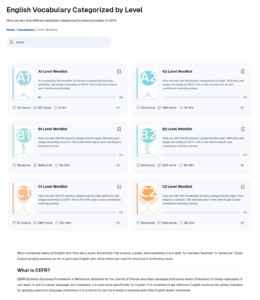 The CEFR Vocabulary Section on Langeek serves as one of the key components within the broader Langeek Vocabulary Page. It offers a systematic approach to vocabulary acquisition, tailored to the guidelines of the Common European Framework of Reference for Languages (CEFR). This dedicated section is organized into six distinct proficiency levels, starting from A1, which covers the basics, to C2, the pinnacle of language mastery.
The CEFR Vocabulary Section on Langeek serves as one of the key components within the broader Langeek Vocabulary Page. It offers a systematic approach to vocabulary acquisition, tailored to the guidelines of the Common European Framework of Reference for Languages (CEFR). This dedicated section is organized into six distinct proficiency levels, starting from A1, which covers the basics, to C2, the pinnacle of language mastery.
- A1 – Beginner: This is where the journey begins. The A1 level introduces learners to the most essential vocabulary needed for basic interactions. Words and phrases at this level are selected to help users navigate everyday situations, such as greetings, simple questions, and responses.
- A2 – Elementary: Building on the foundation, the A2 level expands the learner’s vocabulary to include expressions related to routine tasks. This includes directions, shopping, and basic personal information. The language here is still straightforward but allows for more detailed conversations.
- B1 – Intermediate: At the B1 level, users start to engage with more complex language structures. The vocabulary covers a wider range of topics that enable learners to express opinions, experiences, and events with increasing clarity and detail.
- B2 – Upper-Intermediate: This level is designed for users who are becoming more fluent and confident in their language use. B2 vocabulary includes nuanced words and idioms that allow for more sophisticated and detailed communication in a variety of contexts.
- C1 – Advanced: C1 learners are delving into the finer points of the language. The vocabulary at this level includes abstract and technical terms that are necessary for academic and professional environments. Users can understand and produce longer texts and recognize implicit meanings.
- C2 – Proficiency: The pinnacle of language learning, C2 represents mastery over the language. Vocabulary at this level is highly advanced, allowing users to effortlessly understand virtually everything they read or hear and express themselves with precision and subtlety.
Within each category, learners will find an array of wordlists, thoughtfully organized by topic and type. For instance, one might explore a list dedicated to animals, delving into the diverse terminology used to describe the animal kingdom, or a compilation of useful verbs that are pivotal in crafting dynamic sentences.
A distinctive feature of this section is its focus on the practical application of vocabulary. The selection of words is not arbitrary; instead, it is curated based on their necessity and frequency of use, as stipulated by the CEFR framework. This ensures that learners are investing their time in vocabulary that will serve them well in real-world interactions.
In response to its growing popularity, the Langeek Vocabulary Section has been enriched with additional details for each word. Recognizing the power of visual learning, the section now boasts an extensive collection of images that accompany the words. These visuals serve as mnemonic devices, aiding in the retention and recall of vocabulary by creating vivid associations in the learner’s mind.
Additional CEFR Resources
You can download the A1 wordlist PDF here. Designed by the Langeek team, this resource is freely available for users who lack internet access